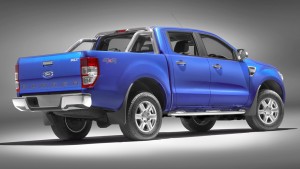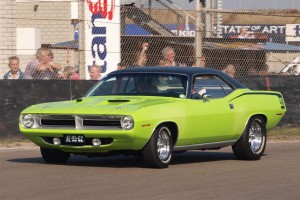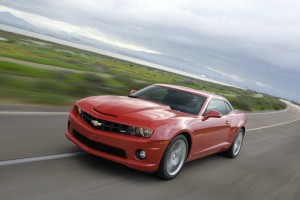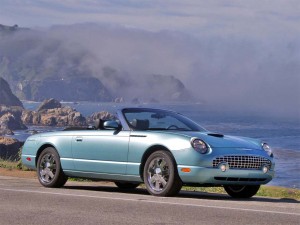Coming up with an all-new name has become a major headache for automakers around the world. It can be difficult to find a name that hasn’t already been taken, and it then can be extremely costly to build consumer awareness.
So, it seems, a number of carmakers are looking back into their past to see if there are once-popular nameplates that can be revived. And with the successful revival of the Chevrolet Camaro, a few years back, it seems that even more manufacturers are going to take this route.
Among the once-popular names we may soon see back in showrooms are the Grand Wagoneer, Barracuda, Ranger and Bronco, it seems. And still others may follow – though looking for a blast from the past does carry some risks, industry analysts warn.
As TheDetroitBureau.com reported this week, Ford Motor Co. is expected to bring back the Ranger pickup, a nameplate it abandoned in the U.S. in 2011, though it continued offering an all-new model overseas. The Ranger would fill a gap in Ford’s line-up now that there are signs American motorists are returning to the once-huge midsize truck segment.
(Click Here for more on the return of the Ford Ranger.)

Ford is now expected to offer a U.S. version of the midsize Ranger pickup, a model it dropped in 2010.
The revival of the Ranger would follow the return of the Chevrolet Colorado and GMC Canyon models that briefly went out of production while General Motors worked up a more modern and competitive redesign of the compact trucks.
Ford also is said to be toying with the return of another once-popular model, the Bronco SUV. It was once a leader in the sport-utility segment but was replaced by more car-like models, such as the Ford Explorer. A new Bronco, sources suggest, would be roughly the size of the latest Explorer, but instead of riding on a car-like crossover platform it would share the chassis of the new Ranger pickup.
Fiat Chrysler Automobiles has brought back a number of model names in recent years, including muscle car mainstays like the Dodge Charger and Challenger. And it may add one more old-is-now offering to that high-powered segment, a revived Barracuda. In its heyday, the ‘Cuda was marketed through the now-abandoned Plymouth brand. Going forward it also would be sold through Dodge.
The sibling Jeep brand is also expected to bring back an old model, this one the big Grand Wagoneer. Though often credited with creating the modern SUV boom, Jeep hasn’t kept up with some key rivals in filling every possible model niche. The revived Grand Wagoneer would be a full-size model to take on the likes of the Mercedes-Benz GL, among others.
(Chevy, GMC hope to expand appeal of Colorado, Canyon twins with new diesel drivetrains. Click Herefor the latest.)
FCA reportedly is filling in dealers on its future product plans during a meeting in Las Vegas. Ford, meanwhile, has reportedly clued in the United Auto Workers Union on some of its plans as part of its ongoing contract negotiations. Formal public announcements could follow in the weeks or months ahead.
There are several reasons why manufacturers reach into their histories to revive old nameplates. For one thing, it is becoming increasingly difficult to come up with good names that aren’t already in use or at least registered by a competitor. That’s one reason many makers have gone the alphanumeric route. But they also know that it’s hard to get worked up about something called an ABC123.
Launching an all-new nameplate, meanwhile, is extremely expensive, a mainstream model often requiring a marketing investment of $100 million or more to establish in the market, notes analyst Joe Phillippi, of AutoTrends Consulting.
But when it comes to these blasts from the past, some of those old model names still carry a lot of positive heritage that automatically tell a story in the collective public mind. That was the case when General Motors brought back the Chevrolet Camaro in 2009. The muscle car went on to dominate the so-called pony car segment for the next five years.
On the other hand, GM’s effort to bring back the once-revered Pontiac GTO name flopped a decade ago. Unlike the retro-styled Camaro, the new “Goat” had a bland and largely forgettable design that failed to connect with consumers.
The same was the case with the Thunderbird, the two-seat roadster Ford tried to launch a decade ago. Over the decades, the T’bird went through a variety of incarnations, from the original 2-seater to a bloated coupe and then into a quirky but less-than-compelling 2-seater again. A variety of product weaknesses resulted in mixed reviews and weak sales, and the Thunderbird was again pulled from the market.
So, while a grand old name can give a new product a head start, it’s not enough to fix a bad vehicle design.
(New Jeeps, including next Grand Cherokee, Grand Wagoneer, delayed. Click Here for more.)




Barracuda or ‘Cuda are naturals but they would need to be sold under the Chrysler division as Plymouth was eliminated. Hopefully these will be real U.S. designed/produced models not rebadged Fiat products.
Some of the resurrected nameplates have been an injustice to the original cars such as the Thunderbird.
Barracuda will be a Challenger with a different grille and taillight and emblems
Of course the Cuda would be a Challenger chassis with some minor styling changes just as pretty much all Plymouth/Dodge models were in the past. The Cuda was considered by many to be more attractive than the Challenger but I like them both – especially the original race Hemi Cuda’s and Darts.
Agreed, you can’t have a Dodge Barracuda; there is too much knowledge and heritage of the car that it would not fly to make it a “Dodge” instead of being a “Plymouth” It would have to fly under SRT-bannerish (if that’s a word?)
The MAIN reason neo-GTO, aka Monaro, and T-Bird failed was the dealer body asking ridiculous prices for them. Yes, the neo-GTO was bland, but with dealers asking $10K down-payments just for testing drives – yes, dealers in my area and others were asking that much just for a test-drive – and other idiotic things, they doomed the car. It would’ve made one helluva stop-gap Camamro, which people associate Holden as the Aussie Chevrolet, or Pontiac could’ve named it GTP Coupe or something else; there was no heritage to this wannabe.
The T-Bird, along with the Marauder, was just WAY over-priced for what they offered. Add in the Marauder was the supposed answer to the Impala SS, which was stupidly killed off by GM two years prior, it answered a question no one longer asked. Lastly, you could build the car from a Jegs catalog, as everything they added to the car, except engine of course, came from there.
The Holden/GTO IMO was decent looking and not a bad re-use of the GTO name if the car performed properly. The T-Bird in all later iterations was a joke of a vehicle to apply the T-Bird name to as they had virtually nothing in common design wise with the original T-Bird which was small, light, peppy and stylish.
ANYTHING is an improvement over even…more…alphanumeric…meaningless…models.
I’m highly anticipating the Dodgemouth Mayflower Prowler.